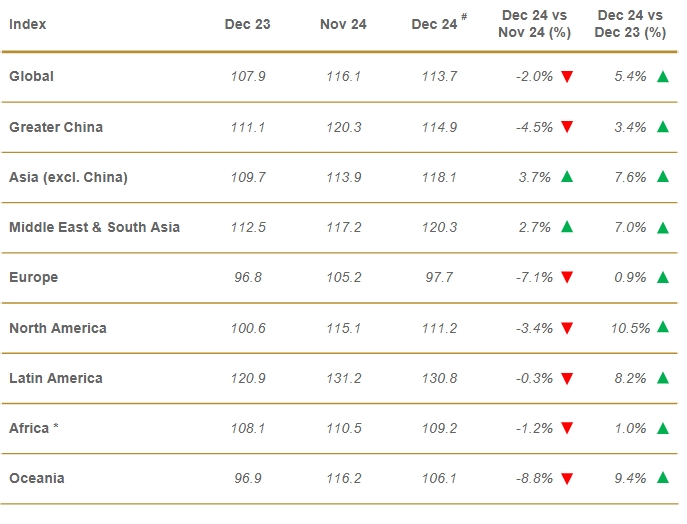Drewry’s Global Container Port Throughput Index declined 2.0% month-over-month (MoM) in December, settling at 113.7 points. Despite the drop, the index remained 5.4% higher year-over-year (YoY), signaling continued recovery. The rolling 12-month growth rate for global port handling climbed to 6.1%.
According to Drewry’s Nowcast model, the Global Port Throughput Index is projected to have fallen another 1.8% MoM in January 2025, suggesting a slowdown in momentum.
Regional Performance Overview
Greater China: Decline in December, but Strong Performance from Ningbo
The Greater China Container Port Throughput Index fell 4.5% MoM to 114.9 points in December, though it remained 3.4% higher YoY. Volume growth in Q4 2024 was relatively subdued compared to the previous year, with the exception of Ningbo, which saw an impressive 21.6% increase in cargo handled versus Q4 2023. In contrast, Shanghai and Hong Kong experienced declines, with throughput down 4.3% and 2.7% YoY, respectively.
North America: Strong Year-End Performance at West Coast Ports
North America’s Container Port Throughput Index dropped 3.4% MoM in December to 111.2 points but remained 10.5% higher YoY. The rolling 12-month average growth rate edged up to 10.6%. US West Coast ports had a particularly strong Q4 2024, with Long Beach reporting a 24.4% YoY increase in volumes, while Los Angeles followed closely with a 21.5% rise.
Latin America: Continued Above-Average Growth
Although the Latin America Container Port Throughput Index declined slightly by 0.3% MoM in December, it remained 8.2% higher YoY. The rolling 12-month average growth rate climbed to 11.1%, nearly double the global average of 6.1%. In Panama, the combined throughput of the country’s five container terminals rose 7.9% in December, while Brazil’s Port of Santos saw an 8.9% YoY increase in volumes.
Looking Ahead
The data suggests that while global port throughput remains resilient, growth is beginning to moderate. With Drewry’s Nowcast model predicting another MoM decline in January 2025, stakeholders will be watching closely for signs of sustained softness in global trade activity.




